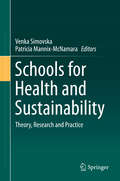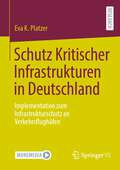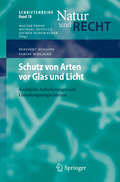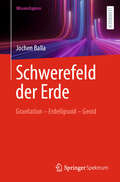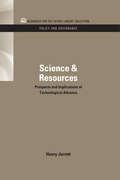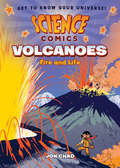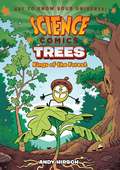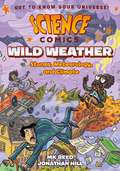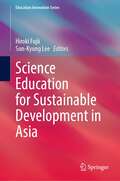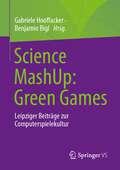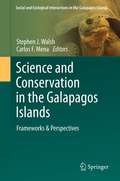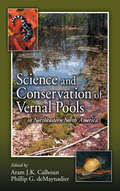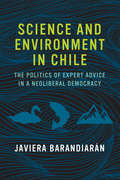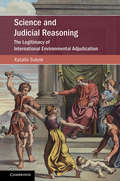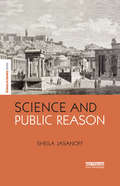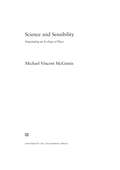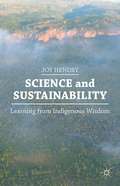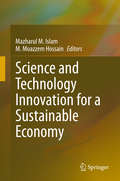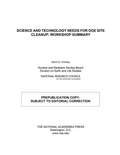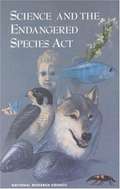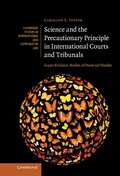- Table View
- List View
Schools for Health and Sustainability
by Venka Simovska Patricia Mannix McnamaraSchools are unique places. They pay a central role in the formation of young people. The importance of how young people are educated and how they are encouraged to live and learn cannot be underestimated. This book advocates for the fostering of agency not only amongst school personnel but also amongst younger generations for health and sustainability. It provides the reader with a new lens with which to discover health promoting schools and education for sustainable development. It invites the reader to look more deeply into both and to accompany the authors on a journey of discovery of the real potential for each to enhance the practice of schooling.
Schutz Kritischer Infrastrukturen in Deutschland: Implementation zum Infrastrukturschutz an Verkehrsflughäfen
by Eva K. PlatzerDer Schutz von kritischen Infrastrukturen spielt eine entscheidende Rolle bei der Aufrechterhaltung täglicher Dienstleistungen und schützt sowohl die Bevölkerung als auch die nationale Wirtschaft eines Landes. Bisher ist die Policy zum Schutz Kritischer Infrastrukturen freiwillig. Ihre Implementation hängt vom Betreiber der Kritischen Infrastruktur ab. Im Zuge der Corona-Pandemie wurden Maßnahmen ergriffen, die zu Veränderungen der Policy-Inhalte geführt haben. Zudem führt das (aktuell im Entwurf befindliche) KRITIS-Dachgesetz zu einer grundlegenden Novellierung der Policy. Dies macht eine eingehende Analyse des Status quo der Implementation durch die Betreiber erforderlich. Die qualitative Untersuchung dieser Arbeit vergleicht anhand von drei Fallstudien die Umsetzung der Policy zum Schutz Kritischer Infrastrukturen an deutschen Verkehrsflughäfen. Die Kernfragen sind dabei: Wie wird die Policy implementiert und wie lässt sich dies erklären?
Schutz von Arten vor Glas und Licht: Rechtliche Anforderungen und Gestaltungsmöglichkeiten (Schriftenreihe Natur und Recht)
by Benedikt Huggins Sabine SchlackeDieses Buch enthält eine umfassende Analyse der rechtlichen Pflichten und Gestaltungsmöglichkeiten zum Schutz vor Risiken und Gefahren für Vögel, Fledermäuse und Insekten durch Glas und Licht. Die Anlockwirkung von nächtlichen Lichtquellen auf Insekten sowie die Kollisionen von Vögeln mit Glas sind allgemein bekannt, aber bislang kaum untersucht worden. Aufgrund neuer Forschungserkenntnisse rückt die Verwendung von Glas und Licht nun stärker in den Fokus des Interesses. Diese rechtstatsächlichen Erkenntnisse werden zusammengefasst und erstmals einer umfassenden systematischen Analyse unterzogen. Das Buch arbeitet die Anforderungen des geltenden Rechts an den Schutz vor Risiken und Gefahren für Vögel, Fledermäuse und Insekten durch Glas und Licht heraus. Im Mittelpunkt steht dabei die Untersuchung der naturschutzrechtlichen Eingriffsregelung, des FFH-Rechts und des besonderen Artenschutzrechts. Das Buch entwickelt Kriterien, anhand derer sich die Erheblichkeit von Beeinträchtigungen von und Eingriffen in Natur und Landschaft bestimmen lassen, und wertet die von der Rechtsprechung zum besonderen Artenschutzrecht entwickelten Signifikanzkriterien für nachteilige Auswirkungen von Glas und Licht aus. Ein weiterer Schwerpunkt sind die baurechtlichen Gestaltungsmöglichkeiten und Vermeidungspflichten der Kommune durch Festsetzungen in Bebauungsplänen. Daneben untersucht das Buch die immissionsschutzrechtlichen Betreiberpflichten zum Schutz vor Lichtanlagen. Im Zusammenhang mit Licht wird der immissionsschutzrechtliche Begriff des Standes der Technik von Vermeidungsmaßnahmen konkretisiert und die Verkehrssicherungspflichten von Kommunen zur Beleuchtung der öffentlichen Straßen und Wege bestimmt. Schließlich wird auch die Vereinbarkeit von Skybeamern mit Bauordnungs- und Naturschutzrecht geprüft.
Schwerefeld der Erde: Gravitation - Erdellipsoid - Geoid
by Jochen BallaFür die Fallbeschleunigung ist der Wert von 9.81 m/s² allgemein bekannt. Wer über diesen Durchschnittswert hinaus die Unterschiede im Schwerefeld der Erde verstehen möchte – welches im Bereich von 9.78 m/s² bis 9.83 m/s² variiert –, muss sich mit der Gravitation des ellipsoidischen Erdkörpers auseinandersetzen. Genau das ist das Thema dieses Buchs. Es erklärt die notwendigen Begriffe und Konzepte, um über das einfache Modell einer kugelförmigen Erde hinauszugehen. Dabei werden auch die physikalischen und mathematischen Grundlagen vermittelt, sodass die Lektüre ohne spezielle Vorkenntnisse aus der Potenzialtheorie möglich ist. Das Buch richtet sich an Studierende der Physik, Geophysik, Geodäsie, Ozeanographie und verwandter Fachgebiete, die eine präzise Kenntnis des Erdschwerefelds benötigen. Sein Inhalt in Schlagworten: • Physikalische Grundlagen • Gravitationsgesetz und Potenzial • Gravitation und Schwerefeld des ellipsoidischen Erdkörpers • Niveauellipsoid und Normalschwere • Gezeiten • Geoid, Quasigeoid und Höhen. Die Produktfamilie WissensExpress bietet Ihnen Lehr- und Lernbücher in kompakter Form. Die Bücher liefern schnell und verständlich fundiertes Wissen.
Science & Life Issues: Ecology and Evolution
by University of California at Berkeley Lawrence Hall of ScienceScience and Life Issues, or SALI, uses several kinds of activities to teach science. For example, you will design and conduct an experiment to investigate human responses. You will explore a model of how species compete for food. And you will play the roles of scientists learning about the causes of infectious disease. A combination of experiments, readings, models, debates, role plays, and projects will help you uncover the nature of science and the relevance of science to your interests.
Science & Resources: Prospects and Implications of Technological Advance (RFF Policy and Governance Set)
by Henry JarrettFirst Published in 2011. Routledge is an imprint of Taylor & Francis, an informa company.
Science Comics: Fire and Life (Science Comics)
by Jon ChadGet ready to explore the depths of the ocean, the farthest reaches of space, and everything in between! Volcanic eruptions, vampire bats, feathered velociraptors, and more await you in SCIENCE COMICS. In a not-so-distant future our world is as cold as a frozen burrito. But can humanity save itself by harnessing a power that dwells inside the Earth? Explode into the world of geology in Volcanoes: Fire and Life! A lot of magic happens under the Earth's crust. Thanks to magma vents, shifting continental plates, and volcanic eruptions, we know that our planet is alive and in motion. Alongside Aurora, a young explorer, you'll learn that volcanoes are just one of the massively powerful forces at work on our planet. From catastrophic destruction to the creation of new land masses, volcanoes have made their mark on our amazing Earth.
Science Comics: Kings of the Forest (Science Comics)
by Andy HirschEvery volume of Science Comics offers a complete introduction to a particular topic—dinosaurs, coral reefs, the solar system, volcanoes, bats, flying machines, and many more. These gorgeously illustrated graphic novels offer wildly entertaining views of their subjects. Whether you're a fourth grader doing a natural science unit at school or a thirty-year-old with a secret passion for airplanes, these books are for you!In Trees: Kings of the Forest we follow an acorn as it learns about its future as Earth's largest, longest-living plant. Starting with the seed's germination, we learn about each stage until the tree's maturation, different types of trees, and the roles trees take on in our ecosystem.
Science Comics: Storms, Meteorology, and Climate (Science Comics)
by MK ReedFurious floods, looming landslides, terrifying tornadoes, ferocious forest fires! Is Mother Nature trying to tell us something? As “snowpocalypse” descends once again, one temperamental weatherman is determined to set the record straight on the myths and misconceptions surrounding the elements. What is the difference between weather and climate? How do weather satellites predict the future? Can someone outrun a tornado? Does the rotation of the Earth affect wind currents? And does meteorology have anything to do with meteors? Stormin’ Norman Weatherby is gearing up to answer all your wildest questions! Get ready to explore the depths of the ocean, the farthest reaches of space, and everything in between! These gorgeously illustrated graphic novels offer wildly entertaining views of their subjects. Whether you're a fourth grader doing a natural science unit at school or a thirty-year-old with a secret passion for airplanes, Science Comics is for you!
Science Education for Sustainable Development in Asia (Education Innovation Series)
by Hiroki Fujii Sun-Kyung LeeThis book presents an Asian perspective on transformative science education in the context of the United Nations' Sustainable Development Goals (SDGs). The chapters are written by contributors who practiced science education for sustainability in a research project entitled “Teacher Education for ESD in the Asia-Pacific Region” from 2017 to 2019, supported by the Japan Society for the Promotion of Science, and the Japanese National Commission for UNESCO. The book showcases the contributors’ innovations in science education for sustainability, presenting case studies of science teaching and learning, science curriculum and assessment, science education in collaboration with local communities, and science teacher education. Embodying Asian sustainability education paradigms, policies, and practices, these case studies depict the diversity and uniqueness of natural, social, and cultural contexts in Asia, while demonstrating their commonalities. Through examining these case studies, this book aims to provide examples for praxis, and prospects, for new science classes, curricula, and teacher education in implementing education for sustainable development.
Science Fusion in Contemporary Mexican Literature (Bucknell Studies in Latin American Literature and Theory)
by Brian T. ChandlerScience Fusion draws on new materialist theory to analyze the relationship between science and literature in contemporary works of fiction, poetry, and theater from Mexico. In this deft new study, Brian Chandler examines how a range of contemporary Mexican writers “fuse” science and literature in their work to rethink what it means to be human in an age of climate change, mass extinctions, interpersonal violence, femicide, and social injustice. The authors under consideration here—including Alberto Blanco, Jorge Volpi, Ignacio Padilla, Sabina Berman, Maricela Guerrero, and Elisa Díaz Castelo—challenge traditional divisions that separate human from nonhuman, subject from object, culture from nature. Using science and literature to engage topics in biopolitics, historiography, metaphysics, ethics, and ecological crisis in the age of the Anthropocene, works of science fusion offer fresh perspectives to address present-day sociocultural and environmental issues.
Science Insights: Exploring Earth and Space
by Michael Anthony Dispezio Gerald Skoog Bobbie Sparks Marilyn Linner-Luebe Marilyn LisowskiReading a science textbook is not like reading a magazine or a story. You usually don't have to work hard to understand a story. You probably won't remember it for a long time, either. But when you read science, you are reading to learn something new. You will need to think about what you read. You will also need to remember as much as you can. You may just read a story, but you will need to study your textbook.
Science MashUp: Leipziger Beiträge zur Computerspielekultur
by Gabriele Hooffacker Benjamin BiglDer Band zum Science MashUp Green Games umfasst wissenschaftliche Beiträge zum Thema "Green Games". Das Tagungsthema „Green Games“ zielt auf Ökologie und Nachhaltigkeit von Computerspielen in Bezug auf Spielinhalte sowie in Bezug auf soziale, kulturelle oder technische Aspekte ab. Der Band umfasst zehn Beiträge. Themen sind Aspekte der Nachhaltigkeit in der Produktion, Umsetzung, Zielsetzung und Vermarktung von Games.
Science and Conservation in the Galapagos Islands
by Stephen J. Walsh Carlos F. MenaIn this launch of the Galapagos series, this book provides a broad "framing" assessment of the current status of social and ecological systems in the Galapagos Islands, and the feedback that explicitly links people to the environment. It also highlights the challenges to conservation imposed by tourism in the Galapagos Islands and the attendant migration of people from mainland Ecuador to service the burgeoning tourism industry. Further, there is an emphasize on the status of the terrestrial and marine environments that form the very foundation of the deep attraction to the Islands by tourists, residents, scholars, and conservationists.
Science and Conservation of Vernal Pools in Northeastern North America: Ecology and Conservation of Seasonal Wetlands in Northeastern North America
by Aram J. Calhoun Phillip G. DeMaynadierSynthesizes Decades of Research on Vernal Pools SciencePulling together information from a broad array of sources, Science and Conservation of Vernal Pools in Northeastern North America is a guide to the issues and solutions surrounding seasonal pools. Drawing on 15 years of experience, the editors have mined published literature,
Science and Environment in Chile: The Politics of Expert Advice in a Neoliberal Democracy (Urban and Industrial Environments)
by Javiera BarandiaranThe politics of scientific advice across four environmental conflicts in Chile, when the state acted as a “neutral broker” rather than protecting the common good.In Science and Environment in Chile, Javiera Barandiarán examines the consequences for environmental governance when the state lacks the capacity to produce an authoritative body of knowledge. Focusing on the experience of Chile after it transitioned from dictatorship to democracy, she examines a series of environmental conflicts in which the state tried to act as a “neutral broker” rather than the protector of the common good. She argues that this shift in the role of the state—occurring in other countries as well—is driven in part by the political ideology of neoliberalism, which favors market mechanisms and private initiatives over the actions of state agencies. Chile has not invested in environmental science labs, state agencies with in-house capacities, or an ancillary network of trusted scientific advisers—despite the growing complexity of environmental problems and increasing popular demand for more active environmental stewardship. Unlike a high modernist “empire” state with the scientific and technical capacity to undertake large-scale projects, Chile's model has been that of an “umpire” state that purchases scientific advice from markets.After describing the evolution of Chilean regulatory and scientific institutions during the transition, Barandiarán describes four environmental crises that shook citizens' trust in government: the near-collapse of the farmed salmon industry when an epidemic killed millions of fish; pollution from a paper and pulp mill that killed off or forced out thousands of black-neck swans; a gold mine that threatened three glaciers; and five controversial mega-dams in Patagonia.
Science and Judicial Reasoning: The Legitimacy of International Environmental Adjudication (Cambridge Studies on Environment, Energy and Natural Resources Governance)
by Katalin SulyokScience, which inevitably underlies environmental disputes, poses significant challenges for the scientifically untrained judges who decide such cases. In addition to disrupting ordinary fact-finding and causal inquiry, science can impact the framing of disputes and the standard of review. Judges must therefore adopt various tools to adjust the level of science allowed to enter their deliberations, which may fundamentally impact the legitimacy of their reasoning. While neglecting or replacing scientific authority can erode the convincing nature of judicial reasoning, the same authority, when treated properly, may lend persuasive force to adjudicatory findings, and buttress the legitimacy of judgments. In this work, Katalin Sulyok surveys the environmental case law of seven major jurisdictions and analyzes framing techniques, evidentiary procedures, causal inquiries and standards of review, offering valuable insight into how judges justify their choices between rival scientific claims in a convincing and legitimate manner.
Science and Public Reason (The Earthscan Science in Society Series)
by Sheila JasanoffThis collection of essays by Sheila Jasanoff explores how democratic governments construct public reason, that is, the forms of evidence and argument used in making state decisions accountable to citizens. The term public reason as used here is not simply a matter of deploying principled arguments that respect the norms of democratic deliberation. Jasanoff investigates what states do in practice when they claim to be reasoning in the public interest. Reason, from this perspective, comprises the institutional practices, discourses, techniques and instruments through which governments claim legitimacy in an era of potentially unbounded risks—physical, political, and moral. Those legitimating efforts, in turn, depend on citizens’ acceptance of the forms of reasoning that governments offer. Included here therefore is an inquiry into the conditions that lead citizens of democratic societies to accept policy justification as being reasonable. These modes of public knowing, or “civic epistemologies,” are integral to the constitution of contemporary political cultures. Methodologically, the book is grounded in the field of Science and Technology Studies (STS). It uses in-depth qualitative studies of legal and political practices to shed light on divergent cross-cultural constructions of public reason and the reasoning political subject. The collection as a whole contributes to democratic theory, legal studies, comparative politics, geography, and ethnographies of modernity, as well as STS.
Science and Risk Regulation in International Law
by Jacqueline PeelThe regulation of risk is a preoccupation of contemporary global society and an increasingly important part of international law in areas ranging from environmental protection to international trade. This book examines a key aspect of international risk regulation - the way in which science and technical expertise are used in reaching decisions about how to assess and manage global risks. An interdisciplinary analysis is employed to illuminate how science has been used in international legal processes and global institutions such as the World Trade Organization. Case studies of risk regulation in international law are drawn from diverse fields including environmental treaty law, international trade law, food safety regulation and standard-setting, biosafety and chemicals regulation. The book also addresses the important question of the most appropriate balance between science and non-scientific inputs in different areas of international risk regulation.
Science and Sensibility: Negotiating an Ecology of Place
by Michael Vincent McginnisIf humans are to understand and discover ways of addressing complex social and ecological problems, we first need to find intimacy with our particular places and communities. Cultivating a relationship to place often includes a negotiating process that involves both science and sensibility. While science is one key part of an adaptive and resilient society, the cultivation of a renewed sense of place and community is essential as well. Science and Sensibility argues for the need for ecology to engage with philosophical values and economic motivations in a political process of negotiation, with the goal of shaping humans' treatment of the natural world. Michael Vincent McGinnis aims to reframe ecology so it might have greater "trans-scientific" awareness of the roles and interactions among multiple stakeholders in socioecological systems, and he also maintains that deep ecological knowledge of specific places will be crucial to supporting a sustainable society. He uses numerous specific case studies from watershed, coastal, and marine habitats to illustrate how place-based ecological negotiation can occur, and how reframing our negotiation process can influence conservation, restoration, and environmental policy in effective ways.
Science and Sustainability
by Joy HendryIndigenous science is often dismissed as quackery or nonsense, out of touch with progress and current events. However, Indigenous peoples have passed down vital information for generations, from which local plants help cure common ailments, to which parts of the land are unsuitable for buildings because of likely earthquakes. These scientific practices that have been developed by Indigenous peoples around the world have been largely ignored by Western colonizers in their lands. From Japan and New Zealand to Australia and Canada, Indigenous science involves environmentally-focused, sustainable practices that allow people to live with the land rather than in spite of it. Here, Hendry examines science through these Indigenous roots, problematizing the idea that Western science is the only type that deserves that name and drawing attention to some of its shortcomings. She takes the reader with her on the learning process and shares a myriad of sustainable examples that can be put into practice.
Science and Technology Innovation for a Sustainable Economy
by Mazharul M. Islam M. Moazzem HossainThis book discusses the subject of pathways to a sustainable economy through science and technology innovations which are regarded as the important components of the ‘4th Industrial Revolution’. The volume has been developed from Bangladesh’s ‘Vision 2041’ agenda which includes development actions needed to catch up with more developed nations. Most importantly, the goals of the ‘Vision 2041’ have been taken from the dreams of the architect of independent Bangladesh, Bangabandhu (Friends of Bengal) Sheikh Mujibur Rahman. His dream was to make Bangladesh the Switzerland of Asia. The Father of Bangladesh Nation was killed by assassins’ bullets along with his most of the family members in August 1975. After his death, the nation moved backwards while recovering from nine months of liberation post war in 1971.Between 1975 and 1990 Bangladesh was ruled by military and quasi military governments. Bangladesh established a true democratic regime in 1996 with Sheikh Mujib’s daughter, Sheikh Hasina, who formed the government after 21 years with a mandate to realise the dreams of her father. Sheikh Hasina, had her own 20 year vision for Bangladesh, called, ‘Vision 2021’, with plans to make the nation poverty free by 2021. After a pause between 2001 and 2008, Sheikh Hasina returned to power in 2009. Under her consecutive three terms she brought Bangladesh back on track and Bangladesh is one of the nations which reduced poverty half under MDGs by 2015. During her third consecutive term Sheikh Hasina, is on the way to transforming Bangladesh into a ‘middle income’ nation by 2021. This volume aims to identify and mitigate the challenges of ‘4th Industrial Revolution’ investigating the areas of science and technology innovations for Bangladesh and for other parts of the world keeping in mind establishing a sustainable economy under UN agendas to 2030 (SDGs). The primary audience for this book are UN development agencies, academic institutions, government policymakers and business leaders of the more developed and developing nations alike.
Science and Technology for DOE Site Cleanup: Workshop Summary
by National Research Council of the National AcademiesThe Department of Energy's Office of Environmental Management is developing a technology roadmap to guide planning and possible future congressional appropriations for its technology development programs. It asked the National Research Council of the National Academies to provide technical and strategic advice to support the development and implementation of this roadmap, specifically by undertaking a study that identifies principal science and technology gaps and their priorities for the cleanup program based on previous National Academies reports, updated and extended to reflect current site conditions and EM priorities and input form key external groups, such as the Nuclear Regulatory Commission, Defense Nuclear Facilities Safety Board, Environmental Protection Agency, and state regulatory agencies. In response, this book provides a high-level synthesis of principal science and technology gaps identified in previous NRC reports in part 1. Part 2 summarizes a workshop meant to bring together the key external groups to discuss current site conditions and science and technology needs.
Science and the Endangered Species Act
by Committee on Scientific Issues in the Endangered Species ActThe Endangered Species Act (ESA) is a far-reaching law that has sparked intense controversies over the use of public lands, the rights of property owners, and economic versus environmental benefits.In this volume a distinguished committee focuses on the science underlying the ESA and offers recommendations for making the act more effective.The committee provides an overview of what scientists know about extinction--and what this understanding means to implementation of the ESA. Habitat--its destruction, conservation, and fundamental importance to the ESA--is explored in detail.The book analyzes Concepts of species--how the term "species" arose and how it has been interpreted for purposes of the ESA. Conflicts between species when individual species are identified for protection, including several case studies. Assessment of extinction risk and decisions under the ESA--how these decisions can be made more effectively. The book concludes with a look beyond the Endangered Species Act and suggests additional means of biological conservation and ways to reduce conflicts. It will be useful to policymakers, regulators, scientists, natural-resource managers, industry and environmental organizations, and those interested in biological conservation.
Science and the Precautionary Principle in International Courts and Tribunals
by Caroline E. FosterBy canvassing a range of international scientific disputes, including the EC-Biotech and EC-Hormones disputes in the WTO, the Case concerning Pulp Mills and the Gabcíkovo-Nagymaros case in the International Court of Justice, and the Mox Plant and Land Reclamation cases dealt with under the United Nations Convention on the Law of the Sea, Caroline Foster examines how the precautionary principle can be accommodated within the rules about proof and evidence and advises on the boundary emerging between the roles of experts and tribunals. A new form of reassessment proceedings for use in exceptional cases is proposed. Breaking new ground, this book seeks to advance international adjudicatory practice by contextualising developments in the taking of expert evidence and analysing the justification of and potential techniques for a precautionary reversal of the burden of proof, as well as methods for dealing with important scientific discoveries subsequent to judgments and awards.
